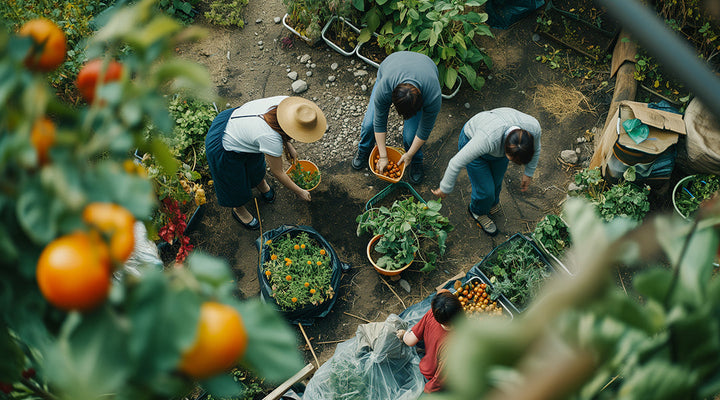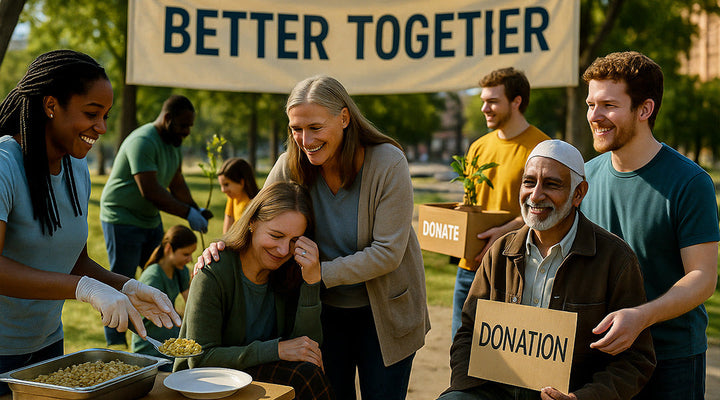
A Cup Of Critical Endangerment - Is Your Coffee Helping Or Harming Wildlife Populations?
For some, coffee is a delicious, occasional treat. For others, coffee is a delicious, daily necessity.
But, for wildlife, coffee can be a dangerous threat!
Coffee is now the second most consumed beverage in the world after water. And, to keep up with such a demand, this commodity is often produced in ways that can harm wildlife, their habitats…and more.
In fact, the overall impact of coffee on wildlife can be overwhelmingly detrimental.
This is why producing a pure, clean cup of coffee is just as crucial to the health of the planet as it is for your body. When it comes to wildlife habitats:
When it comes to wildlife habitats:
- where coffee is grown matters
- how coffee is grown matters
- the amount of coffee grown in one location matters
- avoiding the use of chemicals in the coffee growing process matters
All of these things and more can mean the difference between life and death for wildlife. And, with the ever-increasing popularity of this tasty, health-enhancing beverage, making sure we’re growing this commodity with wildlife and the health of our planet in mind is vastly important.
Here, we want to examine the effects of growing coffee on wildlife, and their habitats, looking at the difference we can make simply by choosing a wildlife-friendly cup of coffee.
The Importance Of Biodiversity

Before we look at the effects of traditional coffee growing practices on wildlife habitats and populations, let’s first examine the importance each and every species is to the environment as a whole.
The importance of wildlife is best examined through the lens of biodiversity, a term that refers to the variety of life living in a particular area or habitat. This includes plants, animals, fungi, even bacteria.
All of these species and organisms live and work together to maintain balance, supporting life for one another.
The removal, or extinction of even one of these species can have far-reaching repercussions.
A perfect example of this can be seen right here in the United States: In the early 1920’s wolves near the Yellowstone National Park were labeled as a threat to nearby populations, prompting their eradication from the park and surrounding areas.
In the early 1920’s wolves near the Yellowstone National Park were labeled as a threat to nearby populations, prompting their eradication from the park and surrounding areas.
So, by 1924, the last 2 known wolves in the park were killed.
And the removal of this one species resulted in an imbalance in biodiversity that would affect animal populations, plant growth, even the route of nearby rivers and streams.
Without the presence of the wolves, elk populations soon increased which led to overgrazing. In fact, elk populations got so out of hand, officials were then troubled with decisions about curbing these populations.
Then, as the elk continued to overgraze this reduced the overall number of aspen trees in the park.
The reduction in these tree populations led to the disappearance of those beavers which relied on the aspens for food.
And, what do beavers do? They build dams in rivers and streams. Remove the beavers, and these waterways can potentially be, and were in this case, rerouted.
Without the wolves, coyote populations also increased, causing the amount of rodents and small game to decrease. And, as their food supply diminished, those populations normally feasting on this wildlife decreased as well, such as hawks, foxes, and eagles.
Now, let’s fast forward to the mid 1990’s when wolves were finally reintroduced into the park. Bringing back one single species to the Yellowstone National Park in 1995, beginning with only 8 wolves at this time, led to the following changes:
Bringing back one single species to the Yellowstone National Park in 1995, beginning with only 8 wolves at this time, led to the following changes:
- Elk and deer populations rebalanced
- Willows and aspen trees dotted the park’s landscape once again
- Riverbanks were stabilized as overgrazing ceased
- Rivers recovered and began to flow in new directions
- Beavers returned to the park
- Songbirds, eagles, foxes, and badgers returned to the park
With continued conservation efforts, wolves have now returned to the Pacific Northwest and the Northern Rockies which has restored balance to these ecosystems as well.
But, mankind did this, right? We removed the wolves on purpose, and then realized this error and corrected it. So, if we simply avoid hunting a species, all will be well.
That statement couldn’t be further from the truth.
Naturally speaking, disease, predators, and limited resources can all threaten wildlife populations, thereby impacting biodiversity.
Now, consider something like the human population. What happens when human populations move into a region? We build.
Everyday land is cleared for housing, retail, and more, with estimations reaching nearly 1% of wildlife habitat destroyed annually, and this doesn’t even touch rainforest regions.
Rainforests make up the most valuable wildlife habitats. And, in 2020 alone, more than 10 million acres of rainforest habitat were destroyed. To put this in perspective, this is roughly the size of Switzerland. A million unique and irreplaceable species are at risk of extinction this century. A million!
A million unique and irreplaceable species are at risk of extinction this century. A million!
Above we saw the effects of one single species being removed from the ecosystem within the Yellowstone National Park.
A million species…I truly do not think it is possible for us to accurately measure the depth of impact the removal of such a vast number of species will have, or is already having, on our planet.
And, unfortunately, the practices involved in growing coffee to meet mass market demands is wreaking havoc on rainforest ecosystems, greatly contributing to the extinction of these same unique and irreplaceable species.
Growing Coffee And Endangering Wildlife
Mass market coffee growing practices negatively affect the planet, including wildlife, in many ways. So, let’s separate these detriments into three categories to get a closer look at what happens when this popular bean is produced.

1- Deforestation
To meet ever-increasing demands for coffee production, mass market companies began creating hybrid coffee plants suitable for quick growth in the sun.
And, with the switch to sun grown coffee, deforestation has become a massive problem for rainforest habitats, robbing multiple species of shelter, water, and food sources, ultimately leading to both relocation and extinction.
When coffee is grown in the sun on large plantations, forests are cleared, shrubs are planted, and coffee is grown…until the soil is no longer healthy enough to continue producing an ample crop. Then, the process is repeated in another area, ravaging natural resources yet again.
It is estimated that for every one cup of coffee consumed, one square inch of rainforest is destroyed.
And, in America alone, we consume roughly 400 million cups of coffee each day.
Do we really need to do the math here?

2- Air, Water, And Soil Pollution
Coffee plants do not thrive in direct sunlight. Considered understory plants, they grow best under a canopy of shade, surrounded by vegetation that protects them from the harsh sun.
But, since large coffee plantations have one goal, to produce lots of coffee quickly, the effects of growing coffee (even hybrid plants) in direct, open sunlight must be combated.
- Fertilizers are used on these plantations to excel growth and protect against leaf browning.
- Herbicides keep weeds at bay.
- Pesticides protect these massive quantities of coffee shrubs from being consumed by insects, birds, and small pests.
And, these harsh chemicals fill the air, seep into the soil, and run off into nearby waterways endangering, even killing, the wildlife within the same (and neighboring) regions.
Here are just a few examples of the effects of chemical use in the coffee growing process and how these affect wildlife populations.
Pesticides - One type of pesticide, organophosphates, targets the nervous system of insects. In bees alone, this poison can disrupt the pollinator's ability to both find pollen and return to its hive.
Other wildlife that may come in contact with this pesticide through soil, water, air, or exposed insects and plant materials, can experience difficulty breathing, skeletal muscle tremors, weakness, loss of coordination, and more.
Fertilizers - Artificial fertilizers used in growing coffee leach nitrates into the soil and nearby waterways. And, these nitrates essentially suck the oxygen out of these waters, killing the aquatic life that call these rivers, lakes, and streams home.
Even the production facilities where such coffee is processed often discharge waste products into nearby waterways contaminating these habitats for aquatic life, killing both the plants and animals within these ecosystems.

3- Climate Change
A byproduct of the practices incorporated in growing coffee in such a way is climate change.
While we already discussed deforestation, we must add here that this practice is the largest contributing factor to climate change as it relates to coffee production, the third largest emitter of greenhouse gasses in the world.
And the bottom line is, we need the world’s rainforests as they store carbon in both the soil and wooded plants while removing excess CO2 equivalents from the air.
Deforestation harms wildlife populations in two ways, both directly as it immediately robs species of needed habitats and resources, and indirectly as climate change leads to rising temperatures.
Ultimately, the increase in temperature throughout these habitats lowers the survival rate of many species as such changes can diminish their food supply, lead to unsuccessful reproduction, and of course alter their overall living environments.
To sum up these effects, where land and waters once teemed with life, vegetation, and activity, such coffee growing practices have stripped these areas down to nothing but barren landscapes which causes imbalances in ecosystems we haven’t even begun to see or experience.
In other words, these ecosystems may never recover. These critical balances in wildlife populations and their habitats have been altered…forever.
And, this is why wildlife species, their habitats, and the planet as a whole must be factored into the coffee growing equation.

Growing Lifeboost Coffee With Wildlife In Mind
At Lifeboost, we absolutely couldn’t bring you the healthiest cup of coffee on the planet without growing our coffee with the health of the planet in mind.
And, this is why we do things differently here at Lifeboost, from farm to cup.
Looking at all of the information we’ve detailed here thus far, when it comes to producing Lifeboost coffee, I suppose you could say this is our “what not to do” manual.
We not only have a strong desire to protect and preserve our planet’s wildlife, we also simply believe that growing great coffee can and should be done naturally, sustainably, with practices that benefit the environment and the wildlife populations where it’s grown.
This is why Lifeboost coffee is grown on small plantations, high in the rainforest mountains of Central America.
Here, our coffee farmers plant coffee shrubs amidst native fauna in the region. This means our coffee shrubs grow with the plant life already existing in the area. And, this also means we never clear, or deforest, the areas where our coffee is grown.
Remember earlier when we mentioned that coffee grows best under a canopy of shade? This is exactly how our farmers grow Lifeboost coffee.
This is exactly how our farmers grow Lifeboost coffee.
Growing coffee shrubs amongst native plant life provides this needed shade canopy, and the cool shade actually makes the coffee mature at a slower rate, allowing the coffee cherries to absorb greater amounts of nutrients while also obtaining a greater depth of sweetness and flavor.
This way of growing coffee is also advantageous to the biodiversity of the area, attracting native birds, insects, and small animals which offer pollination and further enrich (even fertilize) the plants and soil.
Some of these species then provide natural pest control. And, of course, others serve as food sources to those providing this control.
What a beautiful picture of the circle of life!
Each plant and animal species work together in harmony, providing and keeping all things balanced in this often-fragile ecosystem.
And, this beautiful picture we just detailed also means we never incorporate the use of chemicals in our growing or processing methods.
As native plant and animal life interact harmoniously, there is never a need for the use of pesticides, herbicides, or fertilizers.
So, not only do Lifeboost growing practices not hinder wildlife, they actually improve the biodiversity of the areas where our coffee is grown, attracting specific insects, birds, and small animals.
But, our beliefs surrounding the importance of caring for our planet and its precious and needed wildlife populations extend past our growing practices.
We have also partnered with organizations dedicated to protecting our rainforests, financially contributing to efforts as they preserve and protect our planet and critically endangered wildlife populations.
When you drink Lifeboost coffee, you can rest knowing our growing practices help, rather than hinder, these critical rainforest ecosystems.
And, our growing practices increase, rather than destroy, biodiversity.
Even our charitable efforts focus on supporting the plant and animal species native to the regions where our coffee is grown.
Disclaimer: Beginning in 2025, Lifeboost Coffee primarily sources our coffee from farms in Honduras. Our practices of fair wages, sustainable growing methods-from shade to zero chemicals-all are still a part of our operations and are key to what makes our coffee health, delicious, and ethical. Only our farming locations have changed so that we can continue these ethical practices while also meeting our customer demands.
- https://blog.bootstrapbeverages.com/most-consumed-beverages-around-the-world/#
- https://www.arcb2b.com/en/market-information/coffee-the-2nd-most-consumed-beverage-in-the-world/
- https://www.worldwildlife.org/pages/what-is-biodiversity#
- https://yellowstoneinsider.com/2009/05/03/wolves-in-yellowstone-a-short-history/#
- https://defenders.org/blog/2020/03/we-were-wrong-about-wolves-heres-why#
- https://www.adoptananimalkits.com/advocate/wild-earth/params/post/1285590/habitat-destruction!#
- https://nhpbs.org/wild/population.asp#
- https://energymakeovers.com.au/blog/how-does-coffee-affect-the-environment/#
- https://roadcoffeeco.com/blogs/journal/how-biodiversity-affects-the-coffee-industry#
- https://ohiostate.pressbooks.pub/sciencebites/chapter/a-bitter-brew-coffee-production-deforestation-soil-erosion-and-water-contamination/#
- https://www.rainforesttrust.org/saving-endangered-species/
- https://www.theworldcounts.com/challenges/consumption/foods-and-beverages/environmental-effects-of-coffee-production
- https://joesgaragecoffee.com/blog/coffee-drinking-statistics/#
- https://www.thespruce.com/grow-coffee-plants-1902614#
- https://www.ncelenviro.org/resources/organophosphates-fact-sheet/#
- https://www.frontiersin.org/articles/10.3389/fpubh.2022.1004570/full#
- https://cwhl.vet.cornell.edu/disease/organophosphate-toxicity#
- https://www.nationalgeographic.org/activity/ecological-relationships/#
- https://www.lse.ac.uk/granthaminstitute/explainers/whats-redd-and-will-it-help-tackle-climate-change/#
- https://www.nps.gov/articles/000/wildlife-climateimpact.htm#
- References for the article to confirm data and information.










